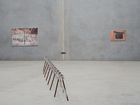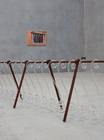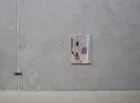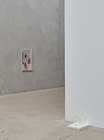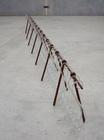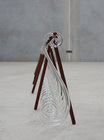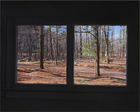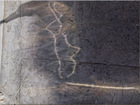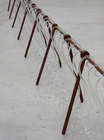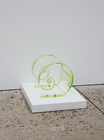A Window is a Verb
text by Tom Melick
I want to begin here, at night, when the daylight from the window is replaced by the bluish, flickering glow of my neighbour’s television. I have in mind the advice of my friend Charlie, who read an earlier version of this text and wrote: “The window is the material to perceive this light and your view through the glass becomes an analogue to your viewpoint or approach to generating the ideas in the essay. I guess most editing approaches would suggest that you go deeper into one idea, but my approach would be to say, maintain this lightness at all costs: shine a gentle light on surfaces and nothing else; a searchlight?” And so this is what I will try to do; allow this note to become like the changing light from the window—day to night, night to day—so that I might maintain a lightness that illuminates the surface of things, and nothing more. This is harder than expected since every image and object seems burdened with thought, feeling and history, and demands its own “interrogation.” Think of the first ever image of a black hole, created from a network of telescopes, showing us a star collapsed under its own weight, infinite density, where not even light escapes. Think of Marx, not known for his levity, who asked “Even the atmosphere weighs upon everyone with a 20,000 pound force, but do you feel it?” He was speaking at the anniversary of the People’s Paper in 1856, but today’s atmosphere is very heavy indeed, and the feeling is difficult to shake.
Italo Calvino spoke of a similar problem in a lecture he wrote, but never delivered, on lightness. “Whenever humanity seems condemned to heaviness,” he said, “I think I should fly like Perseus into a different space. I don’t mean escaping into dreams or into the irrational. I mean that I have to change my approach, look at the world from a different perspective, with a different logic and with fresh methods of cognition and verification.” The weight of living demands lightness, not as a frivolous contradiction, but as a means of survival. Calvino speaks of an anthropological phenomenon where levitation arises through suffering. The shaman, for instance, responds to sickness, drought or evil “by ridding his body of weight and flying to another world, another level of perception, where he could find the strength to change the face of reality.” Thinking of literature belonging to this tradition, he gives storytelling a medicinal quality, curative and mystical, where tactics of the imagination remedy the weight of the world. This remedy, it should be emphasised, isn’t found by fleeing the material world but learning to see it again, where the heaviest of things are viewed from a distance, and maybe even levitate. It seems implausible until it happens.
So let me return to the window in my bedroom. It’s the early morning when I write this sentence and I can see the top of a small tree and beyond that a brick wall and beyond that my neighbour’s window. There are security bars that cast shadows on the windowsill and wall. I first try to study the window—the glass, which is dirty and smudged. The day begins. I get distracted. But when I look again sunlight is coming through, but not without a refractive change, as though this change is the cost of its passage through the glass (Baudelaire in The Painter of Modern Life: “…his eyes see the boisterous sun beating a tattoo upon his window-pane…”). I suspect the magic of glass has everything to do with this tattoo, this passage—with light moving through atoms that are as rigid as crystal but as disorderly as liquid; the fastest thing in the universe entering my room where it has nothing much to do but reveal a dusty floor. The window allows light to enter so that it can loiter, hang about in my room with the dust that, now illuminated, is beginning to look like an array of miniature galaxies. It’s easy to see why glass became a crucial material to places of worship, why it is heavy with the symbolism of creation, wisdom, knowledge, magic and so forth. Nothing remains mundane for long in its presence, entering from above, moving through an amorphous solid, wriggling all the way from the permanent storm of the sun into our interiors. Even the dust—a collection of dirt, skin, hair, crumbs, fingernail clippings and who-knows-what—hints at something superlunary in the light. Walter Benjamin, high on opium, once spoke of curtains as interpreters of the language of wind. Can the same be said of glass and light? And what about the language of imagination?
Such questions and passing observations wouldn’t have come up today if your email arrived in the afternoon, when the light through the window has well and truly gone and the room turns dark and cool. No, a bright morning is the setting in which I’m learning about the exhibition; about the new paintings you’re working on and the glass sculptures you’re making; about what you’ve been up to in New York. For this reason, as I write to you, looking at and through the window, I see you mixing paint and preparing canvas, sketching and planning, creating studies and models, and moving these delicate glass forms around in your studio. I see you figuring out some technique or process, testing a material to see what it will do, how it will change, perform and appear. I like being in the studio with you (even if it’s imagined) because I can follow the way things begin to appear, how they come into view. Maybe I’m jealous that your process begins with the visible world, whereas I seem to sink further into this chair, hunched and heavy, before I’ve really begun. In fact outside this imagined studio—that is, here in my apartment—I’m reading a page or two and putting the book down. I’m going for a walk and returning to discover I’ve locked myself out. I’m finding it hard to breathe in air that is thick with smoke. I’m putting on a pot of coffee and forgetting about it on the stove. I’m trying to write but finding that each sentence scuttles away, as though the words, like ants, have better things to do (Clarice Lispector in Água Viva: “Words—I move cautiously among them as they can turn threatening.”) And then, of course, there’s the weather and the news, both of which are on fire. Collective nervousness, exhaustion, heavy atmospheres and a feeling that time is accelerating towards a point where it’s already too late.
But then what are you up to with these images and objects that seem to speak so calmly? I think it’s this appreciation of making a method out of moments that I find intriguing; of unhurrying time; of turning distractions into acts of attention, details into events, where each object or image is a riddle to the discipline, labour and patience that it takes to make it. In this way (I hope you don’t mind me saying) there’s something very untimely about this work. I’m not talking about the paintings speaking back to the history of photorealism (which, if not ignored completely these days, is usually a punching bag in theoretical debates that have always seemed too rehearsed for my liking). Nor does it seem all that necessary to consider your glass sculptures from within traditions of minimalism (these objects don’t exactly reject representational content and craftsmanship). No, I’m talking about the way your process refuses a dominant version of time that by its very nature and implementation is rushed, extractive and heavy. Rather than abiding by the logic of the audit where “moments are the elements of profit” (Marx quoting a factory report in Capital) your work affords a slowness and care to moments in the form of objects and images. And if we all have to participate, in some way, in what Marx called usurped time, I want to suggest that, by working in the way you do, you somehow return time as form.
What do I mean by this? There are objects and images that seek to take time away from us, or merely abide by the clock that ticks its way into every available material and interaction, exhausting that material (including the body) into submission. These images and objects are everywhere, no need to list them. We could think of them alongside other extractive industries. We could even trace them back to when mechanical clocks were introduced in the fourteenth century, how synchronised time was perfected over the next few centuries, which led to the quantification of the day, which led to intervals of time where the worker’s attention could be seized upon. Such objects and images quantify experience. They calculate what they need to do in order to get something from us. They price our attention. But there are some objects and images that do the opposite, remediating time by giving it a different shape or quality. These images and objects are harder to find and easily missed but offer a glimpse into the plurality of times (for time is not one thing). It’s clear children, for instance, access the plurality of time in play, and make this material. Cardboard boxes become fortresses, sticks become wands, bathtubs become oceans, arms become wings, words become spells. At work here is an imagination that makes use of the materiality of the world in order to create another world, a world inside a world, a different form of time. This is an imagination that gets inside the thing, expands it, makes it flexible, and disobeys intended designs and rules. In play, children reveal the imagination to be no less real than a rock, or a shoe, or a tree, since at every turn a rock could begin to float, a shoe could speak, a tree will break into a dance. The world opens, becomes volatile and sometimes frightening, but to experience it in this way is to give time a shape.
As of writing about—and looking at—my bedroom window, I’ve remembered van Gogh’s Window in the Studio; a drawing he made when he was in the hospital in Saint-Rémy in 1889. Van Gogh outlined the window in black chalk then added, quickly it seems, thinned oil paint and watercolour, leaving patches of the paper untouched. Through the window we see the suggestion of the hospital’s garden, and a bright blue sky. He also included his own paintings in the drawing, which hang, or rather emerge, on either side of the window, like bruises on the wall. But what is most striking is the way he has made a subject of the window itself, where even the bars on the outside become semi-transparent. Everything seems at risk of becoming transparent, or evaporating. The pots and bottles on the windowsill are left as an outline, and it’s as though the picture is not so much unfinished as it is in a process of becoming see-through. So here it’s not the window that we look through but the drawing itself. The drawing of a window imagined as a window. I wonder what time of day van Gogh made this? Did he draw it all at once in the morning or afternoon or return to it at different times? Did he work on it into the night? Certainly there is a spark of the kind of imagination I’m thinking about, where what is supposedly solid, fixed or restrictive—like bars on a window—begin to fade, become light.
Benjamin cryptically and compellingly spoke of the faculty of the imagination as “the gift of interpolating into the infinitely small, of inventing, for every intensity an extensiveness to contain its new, compressed fullness—in short, of receiving each image as if it were that of the folded fan, which only in spreading draws breath and flourishes, in its new expanse, the beloved features within it.” A fragile faculty for sure, like glass, but it’s one that becomes indispensible for creating time where there supposedly is none, or learning to see anew what has been seen (a better definition of Photorealism?), or turning lightness into a virtue, as Calvino and Charlie instructed. To imagine in this way is to project infinite complexity into the finite, expanding the limits of the given. Not without its incongruity, the imagination lends a lightness to the heaviest of forms not by taking something away but by adding to it. (A crude summary of adulthood and its politics is the acceptance of this weight—the given—which calls us into the finite with the trick of reason and keeps us there, where things become “known” and do not spring to life with a gasp.) The limitations of an image or object, then, is not how it has been defined, not the economics of it, not its current applications, but what can be imagined with it, how it can be received, handled, transformed, cared for and expanded, unfolding over and over again so as to see the beloved features within it. This is commonplace and therefore easily forgotten. And that is why, if this note amounts to anything, it’s in letting the day unfold like a fan, where, sunlight or my neighbour’s television, I’m reminded that a window is a verb.
Sydney
December 2020
Works cited:
Walter Benjamin, One-Way Street and Other Writings, London: NLB, 1979
Italo Calvino, “Lightness,” Six Memos for the Next Millennium, New York: Vintage Books, 1993
Clarice Lispector, Água Viva, New York: New Directions, 2012
With thanks to Charlie Sofo.
Written for the exhibition Set, Ditch Projects in Springfield, Oregon, 2020; republished for Out of Place, curated by Oscar Carpezio, Drill Hall Gallery, Australian National University, Canberra, 2021; and Sets, The Commercial, Sydney, 2021.












